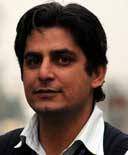Pakistan's myth-busting election |
4. Three-Party Contest
Instead of being a traditional two-party contest between the right-wing Pakistan Muslim League (PML) and the secular, liberal-leaning PPP, the 2013 election witnesses a third powerful political contender as well. Pakistan Tehreek-i-Insaaf (PTI), along with its two older competitors, is reaching out to the people without forming serious alliances. Unlike the past, the powerful military has been overtly and covertly neutral. In a recent address to military men, Army chief General Ashraf Pervez Kiyani not only dispelled rumors of election postponement, but also unequivocally declared that a campaign against terror is Pakistan's war.
5. Transgenders for Public Representatives
In today's Pakistan, transgender individuals are not only eligible to vote but they can also campaign for a parliamentary or provincial assembly slot. In conjunction with last year's court ruling, a separate section allowing a voter to define oneself as something other than male or female was added to the CNIC. As a result, over 1,000 citizens have openly identified themselves as transgender. They are all registered voters and a few are even contesting assembly seats, though there is little chance of victory.
6. Voter Turnout
In 2013, the electorate is significantly more aware of the power of the vote and turnout is expected to be exceptionally high. Though both secular and right-wing Islamist parties have been attacked on the campaign trail, none have decided to boycott the May 11 election. And while terrorist attacks have claimed the lives of 135 political workers and leaders, no high-profile leader has been killed and elections were postponed in only one constituency after an attack claimed the life of one of the candidates there.
7. Youth on Political Agenda
With Pakistan's electoral rolls showing 47.9 percent of eligible voters under the age of 35, youth interests are high on the political agendas of all mainstream parties. Due to widespread use of cellular phones and greater Internet density, Pakistan's youth have really become politicized and are motivated to cast their ballots. They see political engagement as an opportunity to fight corrupt leaders and extremist trends in society. The PTI alone claims 35 percent of its candidates are below the age of 35, an unprecedented phenomenon in traditional electoral politics. On the whole, computerized electoral rolls include 36 million new voters for the 2013 election.
8. Anti-American vote
With the exception of fervor against U.S. drone attacks in Pakistan's tribal regions, the election campaigns revolved around ensuring security, education, health, and employment. The religious right failed to create a coalition similar to the United Front for Action seen in 2002, which will likely weaken their showing in the elections. Their usual 10-percent voting block will not only be shared by the right-wing religious parties, but also by mainstream giants like the PML and the PTI. Both parties are unprecedentedly threatening the stronghold of pro-Taliban mullahs and at least eight alleged hardliners are campaigning on the PML platform to exploit greater prospects of winning.








 Naveed Ahmad is an investigative journalist with special focus on diplomacy, security and energy politics. He jointly heads Silent Heroes, Invisible Bridges, a multi-lingual journalistic organization promoting cross-cultural, cross-religious effort for social integration and peaceful co-existence.
Naveed Ahmad is an investigative journalist with special focus on diplomacy, security and energy politics. He jointly heads Silent Heroes, Invisible Bridges, a multi-lingual journalistic organization promoting cross-cultural, cross-religious effort for social integration and peaceful co-existence.
Post new comment